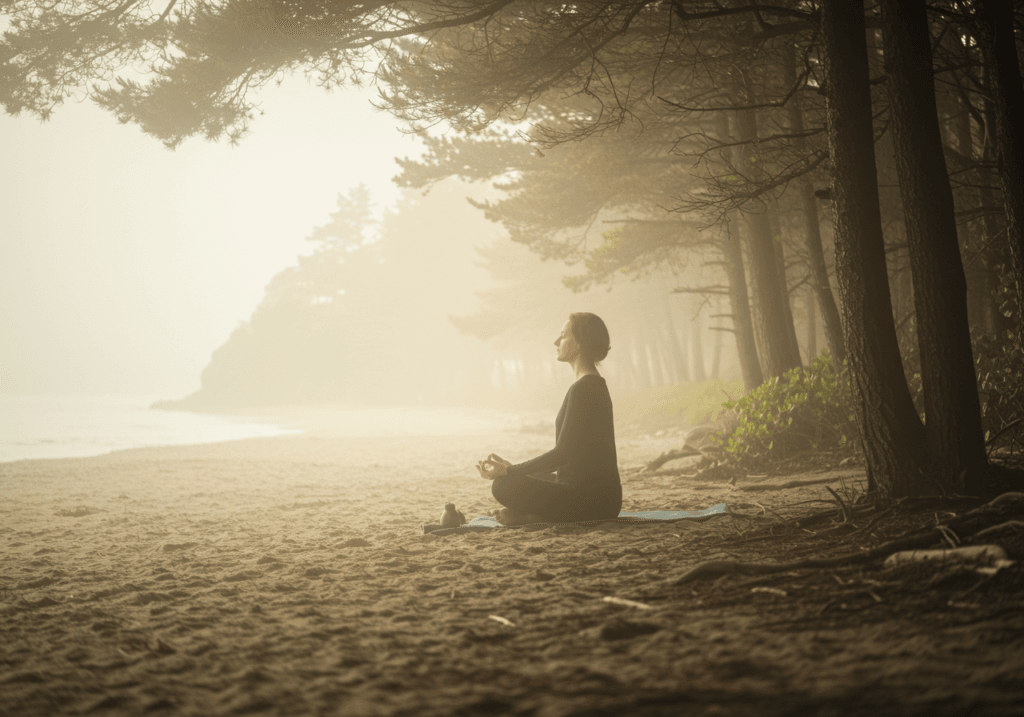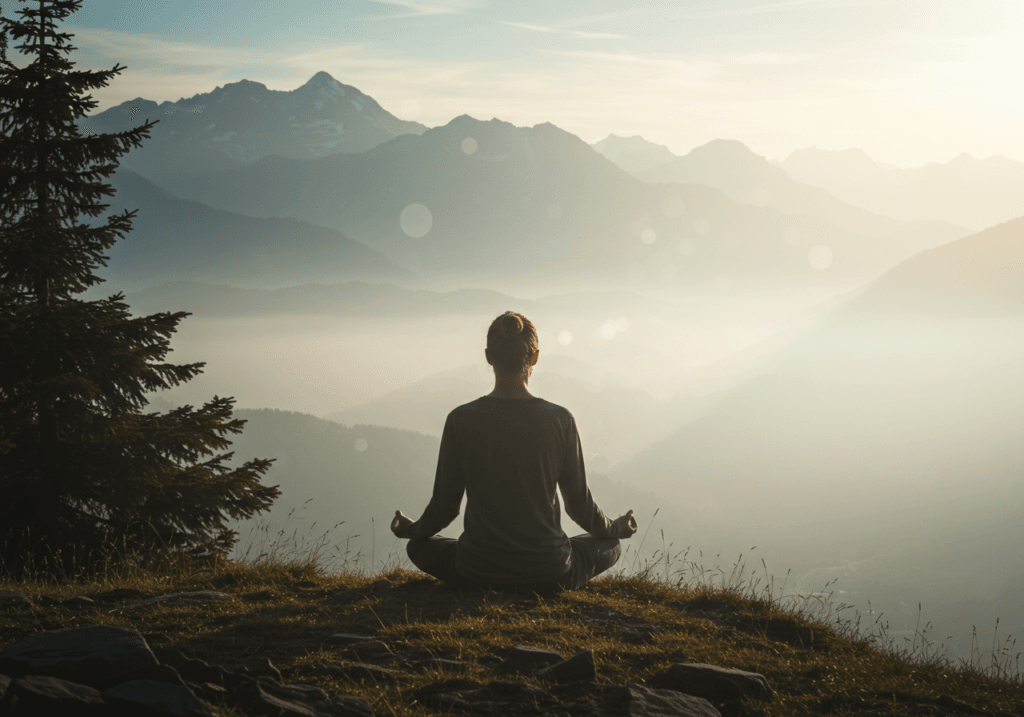Table of Contents
Embarking on the journey of mindfulness meditation can be a transformative experience, leading you toward a state of calm and clarity.
This practice is designed to cultivate an awareness of the present moment, helping you manage stress and enhance your overall well-being.
The key to unlocking inner peace through mindfulness meditation lies in understanding the process and integrating it into your daily life.

Developing a meditation routine doesn’t require you to change your surroundings significantly. What it does demand is a shift in how you perceive and interact with your thoughts.
By focusing on your breath and acknowledging your thoughts without judgment, you begin to train your mind towards greater self-awareness and tranquility.
As a beginner, consistency is crucial. Set realistic expectations for yourself and gradually build up your practice.
Mindfulness meditation is not only about achieving a moment of peace but also about embedding a deeper sense of mindfulness in every aspect of your life.
Ready to start your journey? Let’s explore how you can integrate this powerful tool into your daily routine.
Key Takeaways
- Mindfulness meditation fosters calm and clarity.
- Regular practice enhances awareness and stress management.
- Consistency helps integrate mindfulness into daily life.
Understanding Mindfulness Meditation

Mindfulness meditation emphasizes being present and fully engaged in the moment, fostering awareness and acceptance of your thoughts without judgment. It’s rooted in ancient traditions and differs from traditional meditation by focusing more on conscious presence rather than attaining a specific state of mental tranquility.
Definition and Core Principles
Mindfulness meditation involves tuning into the present moment with awareness, observing your thoughts, feelings, and sensations without judgment. The core principles include fostering an attitude of curiosity and acceptance towards each experience.
Practicing mindfulness helps you build a deeper connection with your thoughts and emotions, encouraging a more balanced and peaceful state of mind. It’s about cultivating a non-reactive awareness, allowing you to respond to situations with greater clarity and intentionality.
History and Origins
Mindfulness meditation has its roots in ancient Buddhist practices, where the concept of mindfulness, or “sati,” was central. Over the centuries, these practices evolved, spreading through Asia and later to the Western world.
In recent decades, mindfulness has been adapted into secular contexts, becoming a popular tool for mental well-being.
Pioneers like Thich Nhat Hanh and Jon Kabat-Zinn played crucial roles in introducing and developing mindfulness practices that are accessible to everyone, emphasizing its benefits for reducing stress and enhancing overall mental health.
Mindfulness vs. Traditional Meditation
While both mindfulness and traditional meditation share the goal of enhancing mental clarity and focus, they differ in approach.
Mindfulness meditation focuses on maintaining moment-to-moment awareness without striving for a particular mental state. Traditional meditation, on the other hand, may involve specific techniques to achieve transcendental or concentrated states.
Mindfulness encourages ongoing awareness and acceptance of thoughts and feelings. In contrast, some traditional methods may emphasize concentrating on a mantra or visualizing specific scenarios for deep relaxation or transcendence.
Preparing for Meditation

When preparing for mindfulness meditation, focus on creating a welcoming environment, maintaining a comfortable posture, and establishing a consistent routine. These elements help make your practice more effective and enjoyable.
Creating a Conducive Environment
Choose a quiet space where you can meditate without interruptions. This could be a dedicated room or simply a corner of a room that feels peaceful.
Consider the use of soft lighting or candles to create a calming atmosphere. You might also benefit from having familiar items around you, such as a favorite cushion or blanket.
It’s important to make this space feel personal and inviting to help you transition into a state of focus.
Keeping your phone on silent and informing others of your meditation time can further minimize disturbances. Play soft instrumental music or soundscapes if they help you concentrate better.
Finding the Right Posture
Your meditation posture is key to both comfort and concentration. Whether seated on a chair, cushion, or directly on the floor, prioritize a comfortable posture that allows you to remain alert yet relaxed.
Keep your spine straight but not stiff. This aligns your body in a natural position and assists with focus.
You can rest your hands on your lap or your knees, palms facing up or down. Ensure your legs are crossed in a comfortable way if you’re sitting on the floor.
If sitting is uncomfortable for long durations, you can try meditating while lying down. It’s crucial to find a posture that supports your meditation practice without causing strain or discomfort.
Setting a Time Limit
Set a specific time to meditate to build consistency in your practice. Beginners may start with just five to ten minutes and gradually extend this duration as they become accustomed to the practice.
Using a timer or a meditation app can help manage your session without the need to check the clock, allowing you to immerse fully in the experience.
A regular schedule, whether in the morning or evening, supports the development of a meditation habit.
Choose a time of day when you feel most focused and least likely to be interrupted to make the most of your practice.
Starting Your Practice

Beginning a mindfulness meditation practice involves establishing a routine that focuses on developing awareness through breathing techniques, understanding your motivation for practicing, and exploring guided meditations.
Emphasize the importance of consistency and patience as you embark on this journey.
Breathing Techniques
In mindfulness meditation, the breath serves as an anchor for your attention. Deep breaths help center your mind, creating a calm and focused state.
Start by sitting comfortably. Close your eyes and breathe through your nose, drawing in a deep breath while counting to four. Hold for one or two seconds, then exhale slowly through your mouth, counting to six.
As you breathe, pay attention to the sensation of air entering and leaving your body.
When your mind wanders, gently guide your attention back to your breath. This simple technique helps cultivate presence, allowing thoughts and emotions to pass by without judgment.
Consistent practice enhances your ability to remain calm and focused, even outside meditation.
Understanding Your Motivation
Identifying your motivation for practicing mindfulness meditation bolsters your commitment. Consider why you are drawn to meditation.
Is it to reduce stress, find inner peace, or improve concentration?
Clarifying your purpose helps sustain your practice, especially when faced with challenges.
Reflect on what you hope to gain. Keep a journal to track how meditation influences your daily life. This helps reinforce your motivation over time.
By understanding your motivation, you tailor your practice to address specific needs, making the experience more meaningful. Remember that motivations may evolve, and that’s a natural part of the journey.
Guided Meditation Basics
Guided meditations are excellent for beginners, providing structure and direction. These sessions typically feature an instructor leading you through the process using audio or video tools.
Guided meditations can vary in focus, such as stress relief, relaxation, or cultivating compassion.
Begin by selecting a short session (5-10 minutes) to avoid feeling overwhelmed. Over time, gradually increase the session length as your comfort and focus improve.
Watch for platforms offering diverse guided meditations, from apps to online resources.
By using guided meditations, you build a solid foundation for your practice, eventually exploring self-guided practice with greater confidence and awareness.
Enhancing Mindfulness During Meditation

Mindfulness meditation can be deeply transformative when you focus on the present moment and cultivate awareness of thoughts, emotions, and bodily sensations. By honing these skills, you can deepen your meditation practice.
Attention to the Present Moment
Focusing your attention on the present moment is central to enhancing mindfulness.
Begin by setting aside a quiet space free from distractions. Sit in a comfortable position, and gently close your eyes.
Direct your awareness to your breath. Pay attention to the sensation of air flowing in and out, noticing each breath’s rhythm.
If your mind starts to wander, gently bring it back to your breath without judgment.
Practicing this focus helps cultivate a deeper sense of presence, grounding you in the here and now.
Observing Thoughts and Emotions
Mindfulness involves observing your thoughts and emotions without getting entangled in them.
During meditation, thoughts may arise frequently. Acknowledge these thoughts without judgment or reaction.
Imagine them as passing clouds, allowing them to drift by.
This practice helps you recognize patterns in your thinking and emotions more clearly.
By fostering a non-judgmental awareness of your mental landscape, you can better manage your responses to challenges in everyday life.
Body Scan Meditation
The body scan is an effective technique to enhance mindfulness by developing a deeper connection to physical sensations.
Start by lying down comfortably. Begin at the top of your head, and slowly move your attention downward.
Focus on each body part in sequence, noticing any tension, warmth, or sensation.
Rather than trying to change these sensations, simply observe and acknowledge each feeling.
This practice encourages relaxation and a profound awareness of your body’s experiences.
Regular body scans can help reduce stress and improve your ability to remain present.
Integrating Mindfulness into Daily Life
Mindfulness can become a seamless part of life when practiced consistently. You can enhance your presence in everyday interactions and tasks, while fostering compassion and empathy.
Mindful Listening and Speaking
Engaging in mindful listening involves giving full attention to the speaker with an open and non-judgmental attitude.
By focusing entirely on the words, tone, and emotions conveyed, you improve the quality of communication and relationship with others.
Encourage natural pauses, allowing yourself to truly process what you’ve heard before responding.
Mindful speaking, on the other hand, involves being thoughtful and deliberate with your words, ensuring they reflect clarity and kindness.
This approach enhances empathy and creates a more meaningful dialogue.
Routine Activities as Meditation
Transform everyday tasks into mindfulness practices by bringing full awareness to simple routines.
Whether washing dishes, brushing your teeth, or walking, focus closely on the sensations associated with each action.
Observe the texture, smell, and movement involved.
This practice, known as informal mindfulness, promotes calm and presence in the moment. It encourages a deeper appreciation of ordinary experiences and can be easily integrated into any busy schedule.
By treating these routine moments as opportunities for meditation, you cultivate a sense of peace and attentiveness throughout your day.
Compassion and Empathy
Mindfulness naturally enhances compassion and empathy by fostering a deeper connection with yourself and others.
You can begin with self-compassion, being kind and understanding towards your own feelings and experiences.
Extend this compassion outward by recognizing and valuing the perspectives and emotions of those around you.
This practice involves an openness to experiencing both joy and suffering without judgment, leading to stronger interpersonal relationships and emotional well-being.
Cultivating empathy can profoundly impact your interactions, promoting a more caring and supportive environment.
Overcoming Common Challenges
Mindfulness meditation offers a path to inner calm, but beginners often face obstacles. Addressing distractions, managing emotions, and sustaining motivation are crucial for an effective practice.
Dealing with Distractions
Distractions, both internal and external, can be frequent during meditation.
Creating a dedicated, quiet space for your practice can help minimize environmental interruptions.
Choose a comfortable posture that supports alertness, as this reduces physical discomfort that might divert your attention.
Racing thoughts are common, and it’s helpful to acknowledge them without judgment.
Use your breath as an anchor. Each time your mind wanders, gently redirect your focus back to your breath.
Consistent practice will gradually improve your ability to maintain focus. Even setting a timer can help create a boundary, allowing you to immerse yourself in the meditation without constantly checking the clock.
Managing Difficult Emotions
Encountering challenging emotions during meditation is normal. Recognize emotions without becoming overwhelmed by them.
This practice of emotional regulation encourages you to observe emotions as they arise, labeling them gently as “anger” or “sadness.”
Allow yourself to experience these emotions without labeling them as good or bad. Use deep breathing to maintain calm.
Inhale deeply, pause, then exhale slowly. This rhythm can help soothe heightened emotions.
Introducing short, guided meditations focused on specific emotions can also aid in processing them.
These tools can be valuable in building resilience and reducing the overall stress associated with negative emotions.
Staying Motivated
Maintaining motivation in your mindfulness journey can be challenging.
Establishing a daily routine with set times for meditation ensures consistency.
Initially, keep your sessions short, gradually increasing duration as you become more comfortable.
Creating a meditation journal to track your progress and note changes in mood or stress levels can offer insights and motivate continued practice.
Joining meditation groups or online communities provides support and accountability.
Set realistic goals, such as a specific number of minutes each day or week, to achieve measurable progress.
Rewarding yourself for meeting milestones helps in reinforcing the habit, ensuring mindfulness becomes a lasting part of your daily routine.
Advanced Techniques and Practices
Incorporating advanced meditation techniques can deepen your practice and enhance your sense of calm and focus.
This section will explore methods that expand upon basic mindfulness meditation approaches.
Loving-Kindness Meditation
Loving-kindness meditation, or Metta Bhavana, involves generating feelings of compassion and love towards yourself and others.
You may start by wishing yourself happiness, health, and peace, and then extending those wishes to loved ones, acquaintances, and even those you find challenging to appreciate.
The practice fosters emotional resilience by shifting your mental habits towards positivity. It helps cultivate empathy and reduces self-criticism, thereby improving your overall emotional well-being.
Regular engagement with this practice can create a more compassionate outlook in daily interactions.
Mindfulness in a Group Setting
Participating in a meditation group offers a supportive environment for your mindfulness journey.
Group settings provide collective energy and motivation, which can enhance individual commitment. You may find that practicing with others helps maintain a regular meditation schedule.
These groups often include discussions and shared experiences, offering new perspectives and insights. While meditative techniques may remain individual, the group dynamic introduces a communal element that can deepen your understanding and practice.
Being part of such a community also nurtures accountability and can aid in stress reduction.
Mindful Movement Practices
Mindful movement practices, such as yoga or Tai Chi, integrate physical activity with mindfulness.
These practices focus on body awareness, breath control, and present-moment attentiveness. Movement becomes an intentional, focused activity, enhancing physical and mental harmony.
Such activities teach you to remain present with your body’s sensations and movements, promoting relaxation and reducing stress. They can be particularly beneficial for those who find sitting meditation challenging.
By synchronizing breath with movement, these practices encourage a holistic, integrative experience that supports mental clarity and physical well-being.
Benefits and Scientific Research
Mindfulness meditation offers numerous benefits for both mental and emotional well-being.
Practicing mindfulness regularly can significantly reduce stress. This is backed by research that shows how mindfulness techniques help modulate stress responses.
A crucial benefit of mindfulness is its positive impact on mental health. By encouraging awareness and acceptance of thoughts and feelings, mindfulness can decrease symptoms of anxiety and depression. This improved emotional regulation contributes to better emotional health overall.
Scientific studies have shown that mindfulness practices enhance focus and concentration. By training your mind to be present, you can increase your attention span and improve productivity. Many people report greater clarity and cognitive function as a result of regular meditation.
Improving sleep quality is another benefit of mindfulness meditation. Techniques that promote relaxation and reduced anxiety levels aid in achieving more restful sleep. Incorporating mindfulness into your daily routine can lead to improved sleep patterns over time.
The practice of mindfulness is supported by an expanding body of scientific research.
Various studies highlight its neurobiological effects, showing changes in brain structures linked to attention, motivation, and emotional regulation. These findings validate the efficacy of mindfulness in promoting holistic health.
Frequently Asked Questions
When beginning mindfulness meditation, adopting simple, effective techniques helps cultivate inner peace.
It is essential to focus on key exercises, understand the importance of breathing, and tackle common challenges, while discovering how mindfulness can be practiced in diverse environments.
What basic techniques can beginners use to practice mindfulness meditation?
As a beginner, you can start by focusing on breathing, body scanning, and noting thoughts without judgment.
Breathing focuses your attention, while body scanning helps identify bodily sensations. Noting thoughts teaches you to observe your mind.
Which exercises are considered essential for cultivating inner peace through meditation?
Exercises like mindful breathing, loving-kindness meditation, and body awareness are crucial.
Mindful breathing stabilizes your mind, while loving-kindness fosters compassion. Body awareness exercises help you stay connected with physical sensations.
How long should a beginner meditate for effective mindfulness practice?
You should aim for 5 to 10 minutes daily as a beginner. With practice, you can gradually increase your session length to 20 or 30 minutes.
Consistency is more important than duration, so find a routine that fits your lifestyle.
What is the significance of breathing in mindfulness meditation?
Breathing anchors your attention and calms the mind. It helps regulate emotions and focus, making it a cornerstone of meditation.
Becoming aware of your breath cultivates presence and supports a deeper meditation experience.
Can mindfulness meditation be practiced anywhere, and if so, how?
Yes, you can practice mindfulness meditation anywhere.
At home, while walking, or during work breaks. Use brief breathing exercises or focus on the sensations of walking. This flexibility makes it easy to incorporate into daily life.
What are common challenges faced by beginners in mindfulness meditation and how can they be overcome?
Common challenges include restlessness, distraction, and self-criticism.
You can overcome these by acknowledging them without judgment. Redirect focus back to the breath as needed.
With patience and persistence, these obstacles become manageable.
Want to deep dive into Mindfullness Meditation?
Mindfulness meditation has become increasingly popular for its proven benefits. Here’s a breakdown of resources to help you dive deep into the subject:
I. Books (Foundational and Practical):
- “Wherever You Go, There You Are” by Jon Kabat-Zinn: A classic introduction to mindfulness by one of the pioneers of mindfulness-based stress reduction (MBSR). It provides a clear and accessible explanation of mindfulness principles and practices.
- “Full Catastrophe Living: Using the Wisdom of Your Body and Mind to Face Stress, Pain, and Illness” by Jon Kabat-Zinn: A more comprehensive guide to MBSR, offering detailed practices and insights into how mindfulness can help manage stress, pain, and illness.
- “Mindfulness for Beginners” by Jon Kabat-Zinn: A more concise and practical guide for those new to mindfulness meditation. It includes guided meditations and simple exercises to get started.
- “The Mindful Way Through Depression: Freeing Yourself from Chronic Unhappiness” by Mark Williams, John Teasdale, Zindel Segal, and Jon Kabat-Zinn: This book explores how mindfulness can be used to treat depression and prevent relapse. It’s based on mindfulness-based cognitive therapy (MBCT).
- “10% Happier” by Dan Harris: A more personal and relatable account of one person’s journey to mindfulness. It’s a good choice for readers who are skeptical or new to the concept.
II. Websites and Organizations:
- Mindful.org: This website offers articles, guided meditations, and resources on various aspects of mindfulness, including its benefits, practices, and applications.
- The Mindfulness Center at Brown University: This center offers resources and programs related to mindfulness, including MBSR training.
- The Center for Mindfulness in Medicine, Health Care, and Society (UMass Memorial Health Care)https://www.ummhealth.org/services-treatments/center-mindfulness: This center, founded by Jon Kabat-Zinn, is a leading resource for MBSR programs and research.
III. Scientific Research and Studies:
- PubMed: This is a database of biomedical literature, including research studies on the effects of mindfulness meditation on various health conditions. Search for keywords like “mindfulness meditation,” “MBSR,” “MBCT,” “stress reduction,” “anxiety,” “depression,” and “attention.”





13 thoughts on “Mindfulness Meditation: Unlock Your Path to Inner Peace”